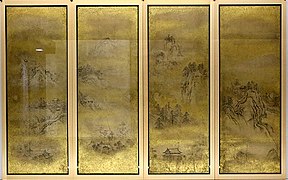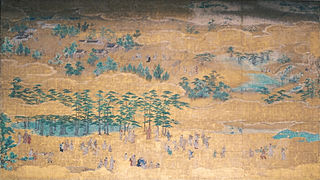Kanō Sadanobu
Kanō Sadanobu ( Japanese 狩 野 貞 信 , nickname Shirojirō (四郎 次郎), Sakon (左近), Ukyō-no-shin (右 京 進); born May 22, 1597 , in Kyōto ; died November 12, 1623 ) was the eldest son by Kanō Mitsunobu , a Japanese painter of the Kanō school .
life and work
As the eldest son of Mitsunobu, he became the successor to the 7th generation of the Kanō family after his death. It is said that he was tutored by his father and that he tried to recreate the style of his grandfather Eitoku , that is, that of the Azuchi Momoyama period . He strove for bold composition, strong colors, naturalistic details and used a lot of gold for the background. He died early so that few secured works exist.
Sadanobu came into the service of Shogun Tokugawa Hidetada . He was mainly responsible for the screens and wall paintings (障 壁画; Shōheki-ga) in Nagoya Castle , which was completed in 1614. However, it seems that other painters of the Kanō school were also involved, such as Kanō Takanobu , Kanō Naganobu , Kanō Jinnojō or Kanō Kōi .
The mural “The Sumiyoshi Shrine” (住 吉 社 頭 図, Sumiyoshi shatō-zu) is not signed, but is attributed to Sadanobu. It adorns a building that was originally located in the Imperial Palace in Kyoto. Later came the building, and with it the mural to the Emman-in (円 満 院), a sub-temple of the Onjō-ji in Ōtsu . It is registered as an Important Cultural Asset of Japan and is now kept in the Kyōto National Museum.
Sadanobu died at the age of 26 and was buried in Hommon-ji in the Ikegami district of Tōkyō.
photos
At the Sumiyoshi Shrine
literature
- Tazawa, Yutaka: Kanō Sadanobu . In: Biographical Dictionary of Japanese Art. Kodansha International, 1981. ISBN 0-87011-488-3 .
- Laurance P. Roberts: Sadanobu . In: A Dictionary of Japanese Artists. Weatherhill, 1976. ISBN 0-8348-0113-2 .
Web links
| personal data | |
|---|---|
| SURNAME | Kanō, Sadanobu |
| ALTERNATIVE NAMES | 狩 野 貞 信 (Japanese) |
| BRIEF DESCRIPTION | Japanese painter |
| DATE OF BIRTH | May 22, 1597 |
| PLACE OF BIRTH | Kyoto |
| DATE OF DEATH | November 12, 1623 |


